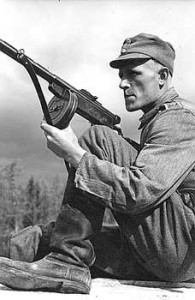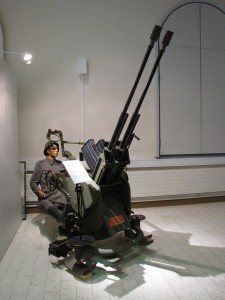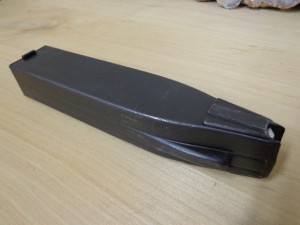Aimo Lahti was born 118 years ago today in Viiala, Finland. He was the greatest gun designer in Finnish history, which makes him a big frog in a pretty small pond. But he was influential far beyond the borders of his Scandinavian homeland.
As a Finnish biography by Simo Kärävä says:
Asesuunnittelija Aimo Johannes Lahti (28.4.1896 Akaan Viiala – 19.4.1970 Jyväskylä), jonka suunnittelemat aseet tulivat 1930-luvun sotilaille ja suojeluskuntalaisille sekä sotiemme veteraaneille tutuiksi usein toistuneen koura- ja olkatuntuman kautta, on jäänyt ihmeteltävän vähälle huomiolle sotia ja puolustusvoimia käsittelevässä kirjallisuudessa sekä tämän vuoksi myös melko tuntemattomaksi muille suomalaisille, sotilaita ja aseharrastajia lukuun ottamatta.
via Aimo Lahti.
Yeah, that. There’s really no run-on sentence like a run-on sentence in Finnish. Anyway, Aimo is little known in the Anglosphere, but his name rings a bell because two of his best-known guns bore his own name: the Lahti M/35 automatic pistol (also adopted in Denmark and in Sweden as the M/40) which combined the natural-pointing grip angle of the Luger with a completely different mechanism, and the Lahti M/39 semiautomatic antitank rifle, advertised for years in the pages of American Rifleman and other 1960s gun magazines. The M/39 was the object of every boy’s envy, later, even if by 1939 it was already marginal medicine on tanks. Lahti would use the same basic mechanism in the beefier VKT 40 anti-aircraft gun, usually seen as a twin mount.
He also co-designed the standard Finnish light machine gun of the Winter and Continuation Wars, the Lahti-Saloranta L/S 26. (It would be replaced by Russian DP LMGs which were captured in vast quantities). He was also responsible for some of the Finnish improvements to the Mosin-Nagant rifle, and for a modified Maxim for aerial and AA use called the VKT. All in all he designed over 50 weapons, counting designs like the M/27 rifle (a modified Mosin).
Lahti’s most influential gun did not bear his name at all. It was the Machine Pistol (“Konepistooli” or KP) 31, the famous “Suomi” (a word which just means “Finland.”) While by 1931 this submachine gun was not entirely revolutionary, we need to bear in mind that the 1931 model was an update of a 1926 model, which in turn was an update of a 1922 run of prototypes. That makes the Suomi, for all intents and purposes, a contemporary of the early Thompson, yielding primacy only to the Thompson and the German MP18.
Like those guns, the Suomi featured sturdy, machined parts and a wooden stock and was very heavy, especially with a loaded drum magazine. The first Suomi drum was unreliable; it was replaced, while a new drum was being designed, by the four-column “casket” mag, that squeezed the four columns down to a single feeding position. The casket mag was a Suomi original that has echoes today in some Russian designs and the Surefire 60- and 100-round magazines.
The Russian submachine guns of the mid-20th Century all owed a great deal to the Suomi design. The PPSh drum is a rather direct copy of the second, reliable Suomi design and shares its 71-round capacity. The Soviet designers were never slow to adapt a foreign idea that could be turned to Soviet military purposes.
Sweden, which built Suomis under license, used the Suomi mags as the feed system for their indigenous submachine gun, the M45 Carl Gustav (and M45 “Swedish K” mags work in a Suomi). But that’s another post.
After the Continuation War ended in 1944, Finland was occupied by a Soviet-dominated Allied Control Commission (there were a couple of token Brits) and by Finnish communist quislings who had been indoctrinated for years in the USSR and were determined to bring the joys of the Russian Revolution to Finland. However, the Finns had hidden tens of thousands of arms, and the thought of the whole nation rising in guerrilla warfare terrified the Soviets a little and their puppets a lot. The Finnish communists reinvented themselves as a political party, competing at the ballet box, and their secret police withered away when their Soviet puppetmasters withdrew.
The spiteful Soviets, whose troops had been shot full of holes by many Lahti designs, demanded that that the Finn retire from arms design, and he did, living on a pension until 1970. His only child became a Finnish Air Force aviator and perished during the Continuation War.
There is a biography of Lahti, Aimo Lahti: Finnish Weapons Designer by Maire Vaajakallio, but it is, alas, only available in the Finnish language.

Kevin was a former Special Forces weapons man (MOS 18B, before the 18 series, 11B with Skill Qualification Indicator of S). His focus was on weapons: their history, effects and employment. He started WeaponsMan.com in 2011 and operated it until he passed away in 2017. His work is being preserved here at the request of his family.





9 thoughts on “Aimo Lahti”
I believe there’s couple of errors in the text
1st, 4-stack “coffin” magazine was Swedish invention for their M/37 subguns (licensed Suomis), and it was adopted by Finns after Swedes. See US patent 2,217,848 by someone Schillstrom
2nd, Finland was never occupied by any “Allied commission”. They just signed separate armistice with Soviet Union and uncle Joe let them be, providing they (Finns) would pay hefty war reparations (they also lost part of former Finnish territories up to and including Vyborg city). What is more interesting that these reparations actually helped Finland to rebuild their industry (instead of paying with money they supplied locally produced goods to USSR) and later conduct a very healthy trade with USSR and now Russia.
1. Thanks for the correction on the magazine. I’ll fix the post sometime today — trying to track down data on the change in drum mags.
Back in the Cold War USSF still learned the Suomi because they were cached all across Finland, Sweden and Denmark, all places we had a stay-behind network ready for whatever happens after the 3rd Shock Army came through (just kidding, that Soviet unit was in East Germany and would have gone straight west for Antwerp and Ostend).
2. Allied Control Commission was 200-odd Soviet officers emplaced in Helsinki under General Alexei Zhdanov, who ran Finland much like Macarthur ran Japan, and for same reason (taking control of defeated enemy, making sure they don’t rise up). Zhdanov was a hero of the siege of Leningrad. But while Mac had occupation army, Zhdanov worked through Finnish authorities — some quislings, some legitimate. Looking at this book, Soviet control was less brutal than elsewhere in eastern Europe. Some interesting facts in there (Zhdanov’s men were less upset that Finns had treated Soviet prisoners harshly than that they had treated German prisoners gently!).
As elsewhere in Europe, Soviets demanded that a list of “war criminals” be tried, but they let the Finns do it, and the Finns couldn’t find half of them and didn’t seriously punish the rest. So it was not an occupation like, say, the occupation of Poland or Germany. (And there were differences in the occupations of the various nations there, depending mostly on the availability of sufficient collaborators).
at a loss for words. I believe Lahti means “lake”. WM should translate the book about Mr. Lake, not just tease and tantalize. Also, if WM or anyone else knows of any, I need Finnish firsthand accounts of both the Russo-Finnish and Continuation Wars
Wiki should be your first stop:
http://fi.wikipedia.org/wiki/Talvisota
There are many good books in english on The Winter War, fewer on the Continuation War which was the war with Russia renewed, this time as ally of the Nazis (in the Winter War, the Nazis were in an alliance with the USSR but did not participate on either side). It was in this Continuation War that Lahti’s son lost his life, I believe in a flying accident.
There also is an excellent film, available at Amazon and other sources. You will also see Lahti’s guns and the Lahti-Saloranta in action, and rare Russian tanks which are, I think, CGI. Our review is here; at the time there was a youtube link which now appears to be hors d’combat. The movie despite being a Finnish production does suffer from some Hollywood exaggerations, it’s not a documentary! It also is, in keeping with the Finnish character, a bit gloomy. Of course we know the ending (the Soviets win) from the beginning.
a bit OT:
Speaking on Finnish character, there’s a sure way to make it not gloomy at all: http://www.youtube.com/watch?v=e7kJRGPgvRQ 😉
Btw, I like Finnish people a lot, they are friendly and hard-working (but I never drink with Finns!)
So, Max, you are saying there might be some truth to the old joke about the Finnish National Dance being a knife fight?
well, I heard that drunken Finns are dangerous, but all drunken Finns that I’ve seen in person so far (and I’ve seen a few, being to Suomi many times) were about as dangerous as a large logs fallen across the road.
Jokes aside, I prefer to stay out of drunken people, be they Finns, Russians or anyone else.
I live about 150 miles from Russian-Finnish border and usually go to Finland on weekends several times a year. And really enjoy these trips.
thanks to all for above references. I will repay with small but valuable coin: Finland has more Tango Palaces per capita than any other country in the world, more even than Argentina. This is a Fact